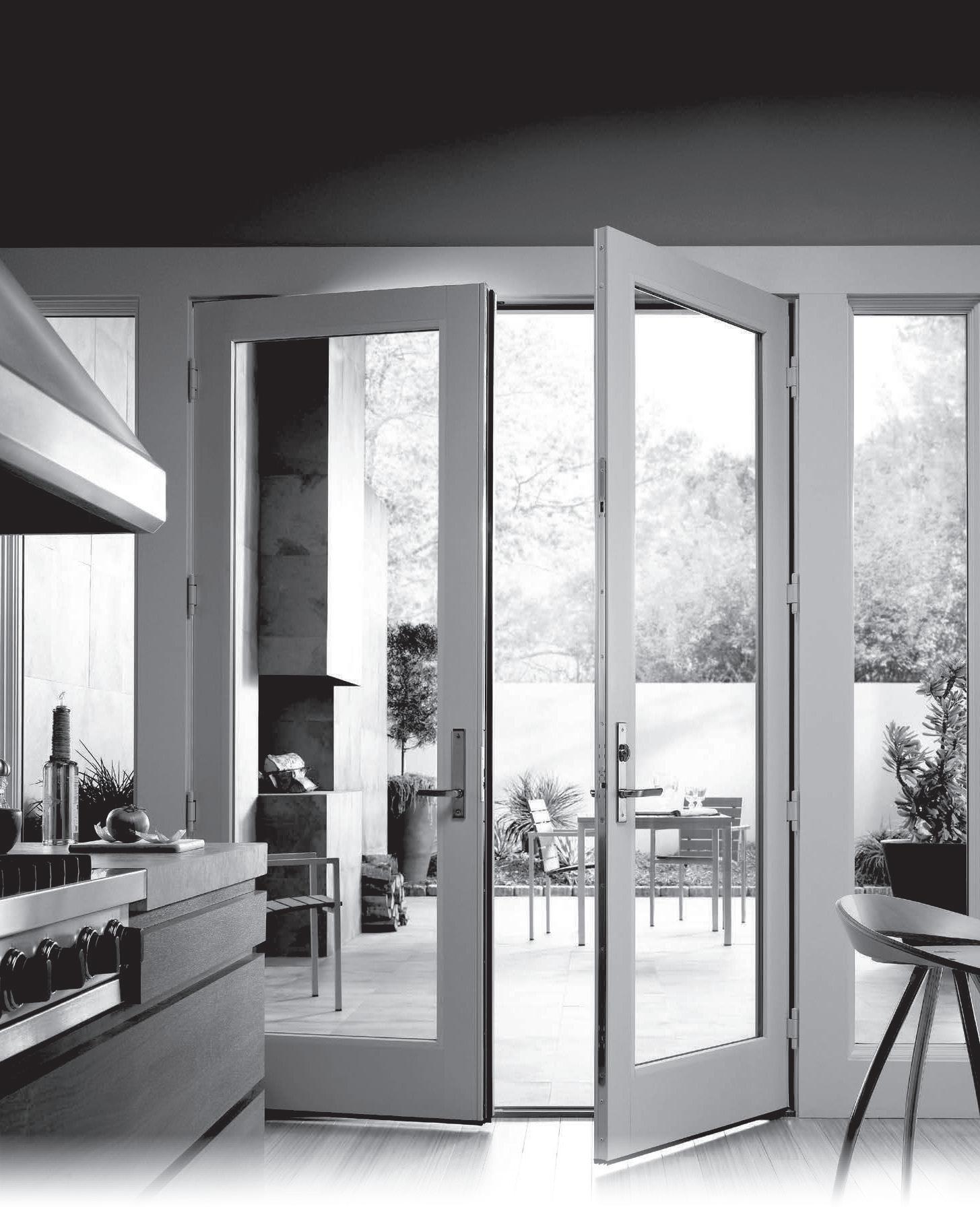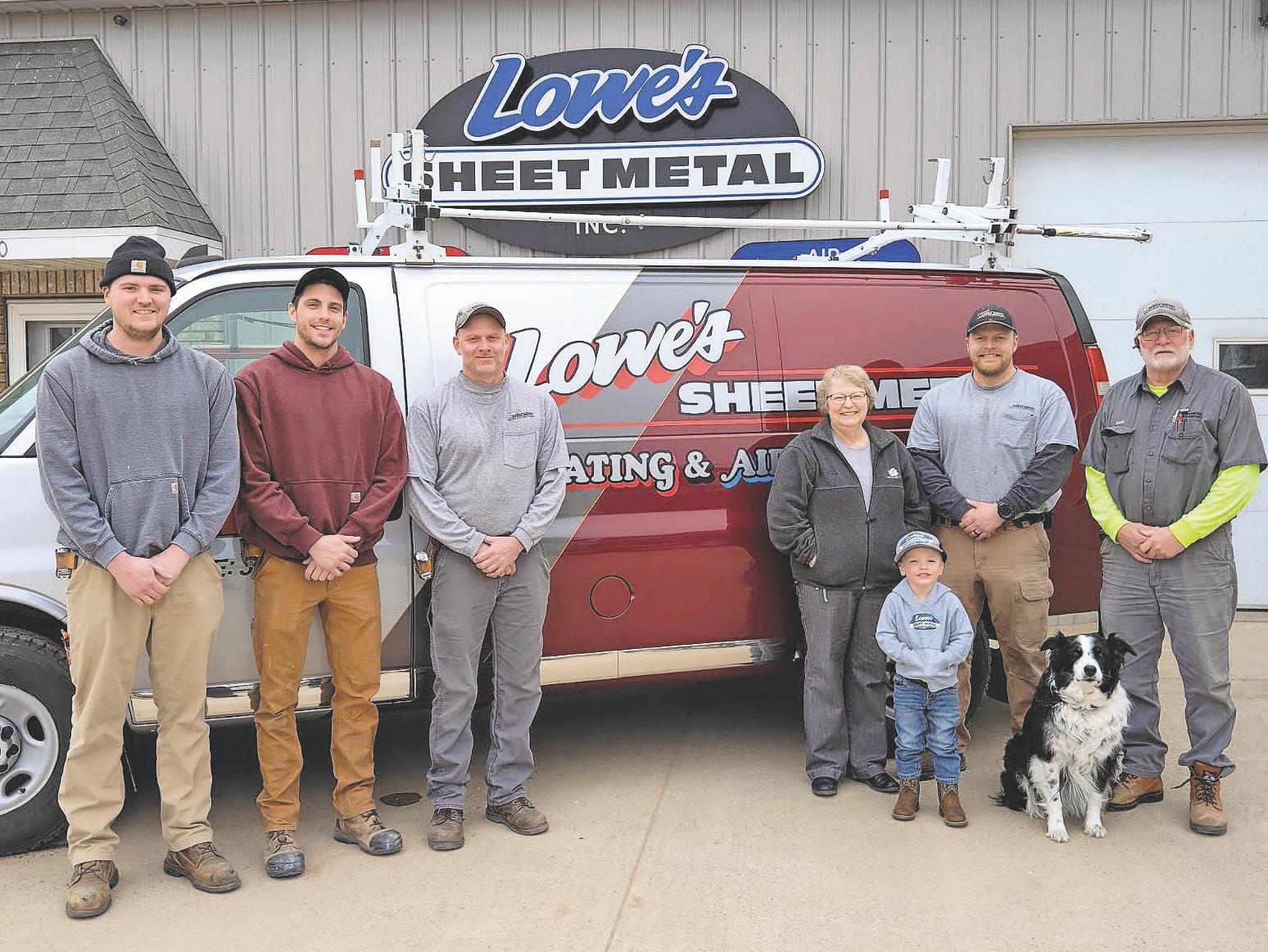April 2023



WORTHINGTON — When Matt and Teresa Widboom transformed their existing farmhouse in 2015, they sought the expertise of Johnson Builders to mesh the historic elements of a home built with plans purchased from a Sears catalog with the modernday space needs of a family of six.
When planning for the construction, the Widbooms met with Worthington contractor Kyle Johnson, who spoke of the importance of a good relationship between homeowner and contractor.


“Both parties have to be comfortable with each other,” said Johnson, who co-owns Johnson Builders & Realty with his younger brother, Jason. “I want to build homes and do projects for people who want me to do them because you spend a lot of time together. You get to know each other really well.”
Construction on the home addition was the start of a great friendship, shared Teresa. So, when it became time to finish the basement seven years later, there was no doubt that Johnson would be tapped for the job. It was a fourth-generation construction company working with a fourth-generation family farm.
“I think it’s a good example of, ‘Here’s what we’ve got,’” said Matt. “We wanted to keep the house in the original project. Kyle was up front and said it was easier to do a complete new build, but it was the house my grandpa had built and my dad grew up in.
“We had several challenges in tying in to a simple, country farmhouse, but he tied it in perfectly,” Matt added.
The addition features elements of a rural lifestyle, such as galvanized tin for the fireplace face, repurposed
Kasota stone that was once a beloved planter box of Matt’s mom, Gloria, and a stone slab created for the fireplace hearth from a large shale rock that Matt discovered in their farm field.
There’s also a bit of whimsy in the
home — a three-story spiral slide installed through the roof of the home during construction that transports both kids and adults from the upperlevel loft to the basement.
Contractor Jeff Meinders renovates space in Ingenthron home | Page 6 By Kari Lucin The Globe
By Kari Lucin The Globe
ADRIAN — Even as March’s final blizzard raged, spring had already begun to blossom for the Green Garden Place, seedlings well-protected from the cold and thriving in three grow houses between Adrian and Lismore.
When they’re ready, the plants will be brought to the Green Garden Place’s location in Worthington, at 1131 Oxford St., for purchase by new and experienced gardeners alike.

It will be the sixth year for owners Dawn and Mark Madison, who purchased the business from Clint and Donna Rohrer of Slayton, after it was started by Roger Rohrer.





“I truly enjoy it. I love the people,” said Dawn. “I love the customers, and helping them — and I get to work with some of the greatest teammates. The staff that works there is just fantastic.”

While the Green Garden Place brings in some retail-ready plants from outside its own operation — from local
sources when possible — it also starts a variety of plants from seed or plug, depending on the plant and the length of its growing season. The earliest Madison starts that process is in late February.

“We start early and the wholesalers start even earlier,” she said.
Throughout March, they’ll keep seeding various vegetables and flowers, attempting to time the process so the plants will be sized appropriately for sale around the time it would be best to plant them.
“It’s a guess every year,” Madison said. “You kind of get a system in place, a general idea.”





Last year’s crop, for example, came out a bit smaller than it had the previous year because there simply wasn’t as much sunlight. While propane heaters can keep the grow houses comfortably warm, they can’t provide the solar power needed to supercharge the seedlings.
The Green Garden Place will likely open in Worthington near the end of April, but the exact timing will be determined by the weather. If it opens too early and the temperature drops to the freezing point, staff has to haul water for the plants, and customers need to bring their purchases indoors rather than planting them.

ST. PAUL — “Peppery but never bitter.” “The healthiest plant of all varieties.” “A clear loser.”



These are some of the takeaways from testers who know their stuff. Winners from the 2022 trials were announced last month by University of Minnesota Extension Master Gardeners, now in their 41st year of testing seeds to determine what grows best in Minnesota’s gardens and backyards. This year’s seed trials focused on varieties of Brandywine tomatoes, okra, burpless cucumbers, daikon radishes, Chinese cabbage and large purple eggplant. Floral seed trials looked at annual asters and dwarf sunflowers. This year, 233 Master Gardener volunteers in 51 counties tested seeds from 48 varieties in home gardens as well as ones located in 14 community settings and two school gardens.
“Because of our short growing season and harsh conditions, very few of the seeds you find at a garden center or catalog come from Minnesota,” said Sue Schiess, a Hennepin County Master Gardener who has overseen the volunteer seed trials for about 10 years. “While the weather is never the same twice, and growing conditions vary across the state, the statewide participation of so many devoted Master Gardeners yields sound, researchbased advice for the home gardener.”
The 2022 seed trials results are now available at https://z.umn.edu/ SeedTrials2023.
Schiess has this preview: “If you want to grow good burpless cucumbers, stick with ‘Tasty Green’ and avoid ‘Early Spring,’ which may grow well elsewhere but not in Minnesota.”

From Page 2
Dawn encourages people to hit the greenhouse twice if needed, once to pick up some plants that prefer cooler temperatures to start once the snow is gone, and then later in the season when the warm-weather plants thrive.



As in any industry, fashions change every year, and every year, growers bring new varieties of flowers and vegetables to the market. There are national trends, but Worthington doesn’t always follow them. This year’s color trend happens to be magenta.
“My experience is the gardeners who are really established in what they grow really know what they want,” Dawn said. “They might try something a little different.”
Some gardeners do ask what’s new on the shelves, and some even make requests. One man asked about a certain kind of Thai hot pepper, and when the peppers came in, they were quite popular.
“That’s the nice thing about being local. You can focus your plants on the things that people like, and that grow here and do better,” Dawn said.
Another gardener asked about Park’s Whopper, a big disease-resistant tomato, and now those are popular too. The vegetable trends tend to mirror food trends, so brussels sprouts and collard greens have had their moments too. Occasionally people ask about okra, so the Green Garden Place generally has
some seed on hand for that. Last year a wide variety of herbs was available.
“Everybody has their thing that makes them want to garden,” Dawn said.
When new gardeners turn up asking for suggestions, she tries to help them figure out what they want, starting with flowers or vegetables. From there, the location becomes important, because some plants prefer full sun and others need a shadier spot. Some people would prefer to start out with a couple container gardens. Once she’s aware of the setup a customer is interested in, she helps them build it to fit them. Keeping it simple can help too.
Sometimes a hanging flower basket might be the best route — dragon wing begonias, for example, are beautiful, tough, handle sun and shade well, selfclean and don’t require pinching, and don’t require as much water as some flowers.
For new gardeners who want vegetables, a tomato or pepper might go well, or green beans or peas from seeds.
“We try to work with you to try to figure out what you really want,” Dawn said.

There are even options for people longing for a greener springtime.
“Buy an herb for your window so you get that wonderful smell and a lovely green plant,” she advised. “I love lemon thyme, basil, lavender and rosemary.”
— Lately I have noticed some pine trees in northwest Iowa that are turning brown and look like they are dying.
Curious about this, I emailed photos to the Plant and Insect Diagnostic Clinic (PIDC) at Iowa State University for their help in diagnosing the problem. More information about the services PIDC provides is available at https:// hortnews. extension. iastate.edu/ pidc.
Based on just the photographs, two

experts suspected pine wilt. Although more definitive, submitting samples is difficult. The greatest success involves
soaking the wood chips in water, and looking for pine wilt nematodes (in the water) under a microscope. And if the nematodes are not well distributed, multiple samplings may be required.
Pine wilt occurs when the nematodes are transferred from tree to tree by pine sawyer beetles that bore under the tree’s bark. Once inside the tree, nematodes destroy the water-conducting tissues of the tree, and resin flow eventually stops. The tree begins to wilt and soon dies.
disease is common in non-vigorous trees that are at least 10 years old. Stress, such as drought and high winds, also make the trees more prone to attack by the pine wood nematode. “Fading” is an early symptom of pine wilt and is characterized by pine needles turning grayishgreen, then tan, and finally brown. While the
entire tree often “fades” all at once, sometimes the top or some of the side branches may be affected first. Wilting typically kills Scots pine within a few weeks to a few months. However, the needles may remain on a dead tree for a year or longer.

If a diagnostic lab finds the pine wood nematode, there is no treatment to
save the tree. The best management is to cut down infected trees and burn, bury or chip them to reduce the risk of pine sawyer beetles spreading the nematodes to healthy trees. The optimal time to remove infected trees is during the winter when pine sawyer beetles are inactive. Do not retain the wood for firewood.

drilling into the trunk of the tree with a large diameter auger drill bit,
In the Midwest more than 90% of the trees killed by pine wilt are Scots pine, and the





WORTHINGTON — A home renovation can be stressful with so many decisions to make about flooring, cabinetry, paint colors and fixtures, and if you’re trying to live in the space while it’s under construction, the stress may be even more prevalent.
For Casey and Mary Ingenthron of rural Worthington, the stress was — for the most part — removed when they timed a three-room remodeling project to take place while they were traversing the deep south with their camper earlier this year.
The Ingenthrons hired Jeff Meinders, whom Casey had worked with on occasion during his stint in construction. Casey knew the quality of the workmanship and felt comfortable having Meinders and his crew come in and do the work while he and Mary spent three months traveling.


“I’ve known Jeff for quite a while so I could trust him,” Casey said.
The home renovation focused on the
kitchen, laundry room and bathroom. Originally constructed in 1978, and with a variety of homeowners since then, the house had gone through some updates. When the Ingenthrons purchased the property, a variety of different flooring made up the main level of the home.
“It originally started as two things,” Casey said of what became a major remodel. “My wife wanted a new bathroom.”
That project was identified when they bought the home in 2018, he said. Then, last fall, Casey pointed to a doorless cabinet in the kitchen that a former homeowner had used for a microwave after the built-in died.

“I said, ‘I guess we need to get a new kitchen’ … and then we have to do the hallways and the floors so it all ties together,” Casey shared.
Their plans grew to include replacing the kitchen countertop and removing the peninsula in favor of a kitchen island.
“Most people that come over sit or stand at the island,” Casey said, adding that the counter space is larger than the peninsula, and they had drawers installed on one side and cabinets on the other, offering plenty of storage space.
The Ingenthrons met with Meinders last fall about the project, and faced a lot of decisions before they left for Texas in early January.
“It was a little stressful because we had to try to plan everything out before we left,” Casey shared. Not only that, but they also had to pack their camper, clear the three rooms, hallways and affected closets, empty the kitchen cabinets and move the appliances into their garage.
“We got everything picked out — the paint color, tile floor and countertops — before they left,” said Meinders, noting that the Ingenthrons worked with Colonial Cabinets of Worthington to make their new kitchen cupboards, laminate countertops and island.

While cabinetry work began in January, Meinders and his crew started on the Ingenthron home in early February. Their first task was to remove the existing flooring — 830 square feet of it, including 5,100 pounds of tile.
“That was all replaced and some of the carpeted hallway went to tile,” Casey said.
Varying heights in the flooring required Meinders to remove material down to the original flooring, which was built with halfinch plywood and half-inch particle board. Damaged flooring in the laundry room and kitchen required replacement which, of course, added to the cost.
When those issues were discovered, Meinders took photos of what he found, texted them to Casey and then followed up with a phone call.
“I didn’t often tell her (Mary) what you called about,” Casey shared with a grin, knowing it likely would have added to his wife’s stress about the construction project while they were away.
Meinders also sent pictures of projects as they were completed, though, and Mary and Casey were quite pleased with what they saw.
Their newly renovated bathroom features an onyx step-in shower, and Mary was quite excited about the photos of the kitchen that were shared.
“When she came in, she liked it,” Casey said of their return home on March 31.
As of last week, they hadn’t yet filled the kitchen cabinets and hadn’t begun their search for new appliances. They planned to move their existing appliances back in from the garage until they get new, likely stainless steel appliances, Casey said.


Meinders, who began working in construction right out of high school and started his own business in 1984, said this was the first time he’s completed a renovation while the
The Ingenthrons wanted their tile flooring to be consistent from the kitchen, through the hallway and into the laundry and bathroom on the main floor of their rural Worthington home.


homeowners were being snowbirds. He said it worked well because his crew could come and go as needed.
“Casey and Mary were great to work with,” Meinders said.

Casey said the same about Meinders. While the construction was going on, the Ingenthrons enjoyed their three-month trip that went from Frisco, Texas (their first destination was to attend the NDSU-SDSU football game), through the Gulf Coast states and into the panhandle of Florida before working their way down Florida’s Gulf Coast and back up the Atlantic Coast, into Georgia and then northwest through the Great Smoky Mountains and back toward Worthington.
As for Meinders, he’s moved on to his next project. His business can
take care of everything from the very little to the large construction projects, including renovations and new construction. He also does light commercial work.
He does have time to add projects into his schedule this year, and said his biggest struggle is finding subcontractors. On the Ingenthron project, he did all of the painting and laid the tile flooring.
Meinders credits the industrial arts and shop classes he had at Worthington High School in the 1970s for giving him a solid education in the trades. That education, and getting hands-on training alongside Eldred Kingery when Meinders first started in construction, has led to a longstanding career.





ST. PAUL — Since emerald ash borer (EAB) was first detected in North America in 2002, the invasive beetle has killed hundreds of millions of mature ash trees. After an attack, branches and trunks weaken and the trees become more likely to fall.
Though this degradation has historically been attributed to damage from the beetles, new research from the University of Minnesota confirms that fungi play a significant role in the process.
Researchers from the Department of Plant Pathology and the Minnesota Invasive Terrestrial Plants and Pests Center recently published their findings in the journal Forests.


“When ash trees get attacked by the emerald ash borer they lose structural integrity quickly, limbs and the main stems can fail and the tree becomes hazardous. We now know the identity of several of these very aggressive pioneer species of decay fungi that are responsible,” said Robert Blanchette, a professor in


the Department of Plant Pathology. The study was conducted by testing wood decay fungi on ash wood samples under laboratory conditions using fungal species that were previously obtained from beetle galleries. By learning how much wood degradation these fungi can produce in a short period of time on ash wood, researchers could infer the role they play in the loss of structural strength of beetleattacked. The researchers found:
► Several aggressive pioneer species of white rot fungi associated with EAB galleries caused extensive degradation of wood cell walls.
► The wood samples treated with decay fungi experienced a significant loss of biomass.
Significant structural damage of wood cells was documented using scanning electron microscopy.

► Since some very aggressive decay fungi associated with EAB galleries were able to produce an important loss of wood structural strength in a relatively short period of time during this study,

researchers concluded these fungi likely play a major role in contributing to the loss of wood integrity and hazardous tree conditions after EAB attack.
“It is still not clear how these fungi get involved with EAB as the beetle is not specialized in carrying fungal spores, but our previous studies show that these fungi are in fact associated with EAB galleries. Based on that and the extensive decay ability some of the fungi showed during this study, it is clear that they can greatly contribute to the loss of structural strength observed on EAB-attacked trees,” said first author Sofía Simeto, a graduate student in the Department of Plant Pathology.
These findings help land managers, municipalities and property owners better understand what happens to the trees after EAB attack and demonstrate the need to remove EAB-affected trees before these aggressive decay fungi become established.
Ash trees left standing without treatment after EAB attack will lose their structural integrity and rapidly become hazardous and subject to branch, limb and trunk failure. These findings will help stakeholders make safer decisions while working with infected trees.
This research was funded by the Minnesota Invasive Terrestrial Plants and Pests Center (supported by the Minnesota Environment and Natural Resources Trust Fund as recommended by the Legislative-Citizen Commission on Minnesota Resources) and USDA Hatch project MIN22-089.


From Page 1
At the time it was installed, the basement was essentially a large, unfinished room.
“The basement was originally going to be done in 2015 when we did the bigger project upstairs,” Teresa said.
Instead, they opted to save up some money and wait a few years. Ultimately, Teresa said, the goal was to have it finished by the time their oldest, Riley, graduated from high school in 2022.

“For five years this was our basketball room,” said Matt, adding that they also had a wrestling mat and ping pong tables in the space.
“The slide is a big element with the kids,” Teresa added. “This was strictly a fun space and the rest of the house could remain tidy.”
Teresa said when she and Matt began talking about their home addition, they wanted a feature that would be super unique and memorable for their kids and one day, grandkids. It was among items that topped their list of nonnegotiables.
Matt’s initial idea was a fire pole that would take someone from the upstairs
to the basement. A pole, however, brought with it too much liability. Still, they mentioned it to Johnson.
“Kyle asked, ‘Would you ever consider a slide?’” recalled Teresa. “It took us about 14 seconds to say ‘Yes!’”
“We did the research and did it right,” said Johnson, adding that he found a very reputable company that provides slides all over the U.S. “This one was custom made for this exact set-up.”
It was one of the last elements installed during the 2015 building project, and had to be dropped into place with a crane.
“It was very tempting for all of us workers to go down it right away,” Johnson said with a grin. But, they decided the Widboom family should be the first to use it.
Teresa kept the kids home from school on the day the slide was installed, thinking it would be an all-day process. She brought donuts and pizza to celebrate the occasion and then, since Matt was at a meeting in St. Cloud related to his role then as a Nobles County Commissioner, she made the kids wait until he got home that evening before they could try it out.
CONCEPTS: Page 10

It’s safe to say the slide has been used thousands of times by the Widboom kids.
“It had a lot to do with the design of the whole house,” Matt said of the slide. “A lot of things revolved around the shaft.”
“I think it’s really fun and I’m really proud of it,” added Johnson. “I’m glad it’s the Widbooms that will get to have years and years to enjoy it.”
At the bottom of the slide is the red and black wrestling mat previously used in the basement space, another repurposed item that came from the high school.
Matt and Teresa’s vision for the basement was to have a bar with a place to prepare food and drinks, as well as a gathering space for family and friends. The space also includes a spare bedroom (currently used as a game room) with a large walk-in closet, and a bathroom.
“We knew that we would be spending a lot of time down here as a family,” Teresa said, adding that they wanted a bar area that would function more as a table in which the family could gather around for pizza or conversation. Around the corner, a wall-mounted television is used primarily for watching big games, whether it be the Twins, Vikings or whatever.
“We’re not really big TV people, but we knew we wanted the space,” Teresa shared.
The adjacent wall is the accent wall of the space. It features more of the repurposed galvanized tin, tying in with the fireplace on the main floor. The tin, said Johnson, was taken from a large stockpile in the grove on his acreage. It also features rough-sawn pine purchased from a sawmill and made into shiplap to match the ceiling. A ledge on the accent wall, created from reclaimed brick, can be used for additional seating.

“My grandfather purchased two railroad cars of old Chicago brick,” said Johnson, who incorporated about 1,500 bricks
into the Widboom basement between the ledge, a small stage and the backdrop for the bar. Another 1,500 bricks were used in a different project by Johnson.
The Widboom family helped Johnson sift through the bricks, remove the mortar and clean them up for reuse.

The basement floor is stained concrete with a large rug in the sectional seating area of the room.
“We put in-floor heat in when we did it, knowing we would be down here a lot,” Matt said.
The focal point of the room, though, is the bar, which features a large table and kitchenette countertop all created from rough-cut slabs harvested from a large oak tree near Lamberton.
Johnson had heard about the wood, taken from a 4.5-foot-wide tree, and drove to the site in March 2022. He and Widboom brought five pieces home, cut and trimmed them to more manageable pieces and then transported them to an individual with a wood kiln, where they stayed for three months.
Johnson said he’d seen a lot of epoxy tables but had never done one. He was happy the Widbooms let him experiment with their project.
“It was this immense amount of work to make the wood tops,” Johnson said. “It needed many elements to happen — a homeowner that had faith and trust in me to create something; myself to drive the project forward and the expertise of Richard Phelps and Josh Peterson, who played large roles.”
Phelps owns Colonial Cabinets in Worthington and Peterson works for Johnson Builders.

“We did it after hours — in the evenings we would work on it,” Johnson shared. Many hours were spent sanding the wood down to create a consistent surface, and bow-tie-look wood pieces were added as decorative features within a split in the wood. A coffee-colored epoxy was poured into the split and hardened, and when that was sanded down, a clear coat of epoxy was applied to the entire piece.

The table top was one of the last items to be completed in the basement renovation, installed just prior to Riley’s graduation. The cabinetry in the bar area, as well as two floating shelves with undermount lights, were constructed by Colonial Cabinets, and Teresa incorporated a wine cabinet she’d found years ago at an occasional shop and a large mirror that had once belonged to her grandmother.
Johnson said the entire basement renovation was completed in about three and a half months.

He’s happy with the finished space. “I want to be the type of builder that is recommended for many projects, but especially when people really want to do something creative and unique,” he said.
As their construction business



heads into the warmer months, Johnson said they’re busy, but they’re always looking for work.
“We specialize in whatever pays the bills,” he said with a laugh, adding that they have a great main core in their construction crew, and hire some seasonal help during the summer. Bob Paplow and Rod Hibma have been core employees of Johnson Builders for more than 30 years. Both helped in teaching Kyle, along with his uncle, Mike, the construction industry.
Johnson Builders was started by Miles Johnson in 1938, with Donavon Johnson taking over the business at a young age. Donavon’s sons, Steve and Mike, purchased the business in 1985, and Kyle and Jason, sons of Steve and nephews of Mike, bought it on Dec. 31, 2019, beginning the fourth generation of ownership.


The kitchenette counter is made from two slabs of oak that were pieced together and given multiple layers of epoxy coating. The brick wall was constructed from reclaimed Chicago brick Kyle Johnson’s grandfather purchased decades ago.
 Buntjer
Buntjer

Julie
/ The Globe
“I want to be the type of builder that is recommended for many projects, but especially when people really want to do something creative and unique.” - Kyle Johnson
























